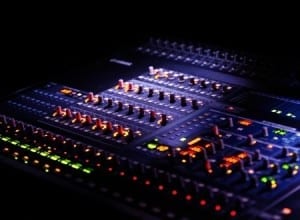How to Mix Electric Guitar
We've written quite a bit about how to get great electric guitar tone on recordings, whether you are miking an amp or going directly into your DAW and using software guitar sounds. But just as important is how you mix that guitar once you have it recorded.

The following are a few things to consider when you are ready to make sure the great tone you've worked so hard to get fits well with the other instruments in your song. These tips are primarily aimed at electric guitar tracks , though the underlying principles can be used on acoustic tracks, as well. In fact, the concepts here can be applied to nearly any instrument you are mixing.
Consider the Overall Arrangement of the Song
First and foremost, you want to think about what your guitar track is intended to do to help your overall arrangement. Typically, guitars fall into one of three broad categories:
- The primary instrument. This is where the guitar receives more focus than any other track other than the vocal. In these “guitar songs,” the guitar will be out front in the mix and will receive all the attention – so make sure that the aforementioned tone is the best it can be.
- The rhythm track. In this case, the guitar serves to help the rhythm and acts almost as a percussion instrument. In this case, you’ll want to make sure the track works well in conjunction with both the bass and drum tracks. This means that not only are the volumes of these three instruments set to work together, but that the recordings of all three are tight and form a good pocket for the song.
- The ambient guitar track. There also are many ways guitar tracks are used to create ambiance and additional noise on a track. Because of the wide variety of tracks, there’s no one way to mix these. Just remember to make sure these serve the song in the best possible way.
Make Panning an Important Part of Leveling
Getting the right level for your guitar track is a huge part of making sure your track sits well in the arrangement. But you also need to consider that panning is an extremely important part of getting the best sounding levels, as well.
For example, if you are mixing one of the aforementioned “guitar songs,” you want to give your track space to be heard without overpowering the vocals. One way to do this is to pan the guitar right or left to a spot in the mix where it can have its own space but is still out of the way of the vocals.
On the other hand, if you are mixing your guitar purely as a rhythmic instrument, you may want to pan it to the same position as, say, your bass track to create a more solid rhythm section.
Tone Settings Revisited
Remember that great tone you spent so long getting before you started mixing? Don’t be afraid to change it.
After you get the levels and panning right, you may find that the guitar that sounded so good on its own just doesn’t “sit” well in your new mix. This often has to do with certain frequencies from other instruments interfering with each other. This means that you’ll often want to play with the EQ and compression settings again after you mix, though beware that making drastic changes can throw off your levels. If you are using digital guitar sounds, of course, you may want to go back and adjust those, as well.




